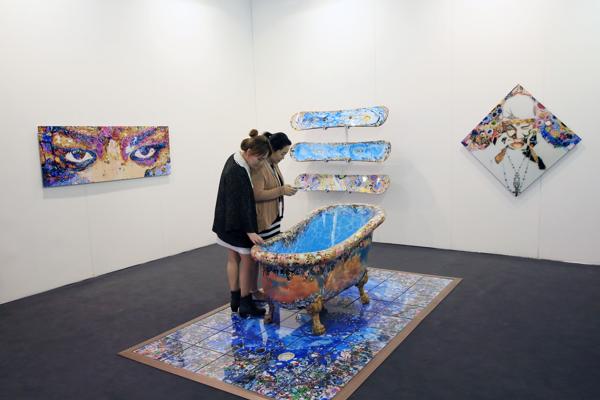
Art Beijing drew more than 80,000 visitors last year, not just from the art world but also ordinary citizens.[Photo/Provided to China Daily]
Since its launch a decade ago, Art Beijing has strived to be both a dynamic platform for fine art and a holiday destination where families can have fun.
The founder of one of China’s long-standing and leading art fairs, Dong Mengyang compares Art Beijing to a superstore where people from different walks of life can find things they like and make discoveries that will broaden their vision of fine art.
Since the launch of Art Beijing in 2006, the Beijinger in his mid-40s, has wanted the event not to be a typical contemporary art fair that is too fancy or upscale and scares people away. Rather, he wanted it to become a dynamic platform for art and a holiday destination where families can have fun.
The fair is held annually from April 30 to May 3 at the National Agriculture Exhibition Center, coinciding with the May Day holiday.
His plan of “serving the people” has proved to be a successful strategy.
Statistics from the Beijing-based Art Market Research Center show last year’s fair drew more than 80,000 visitors. There, 98 percent of the 140 galleries and art institutions that participated sold works with 60 percent of the deals done at prices ranging from 100,000 yuan ($15,385) to 200,000 yuan.
The original stock of tickets for last year’s show sold out within the first two days, and Dong says they had to print more after more people wanted to visit the show after seeing photos of eye-catching artworks on social media services Weibo and WeChat.

Art Beijing drew more than 80,000 visitors last year, not just from the art world but also ordinary citizens.[Photo/Provided to China Daily]
“At first, I felt that the ticket price at 100 yuan was quite expensive, and I worried whether people would buy them,” Dong tells China Daily.
But he says the people’s enthusiasm showed that they had realized that Art Beijing was not only for professionals-artists, dealers and collectors-but it was a place where people could see artworks that are different from those displayed in public museums.
At this year’s fair, there will be more than 160 galleries and institutions from home and abroad displaying contemporary works, classic pieces, designs and public sculptures. The exhibits will be placed around the exhibition center’s former Soviet-style building, its latest exposition venues and also its public spaces.
A graduate of printing art from the prestigious Central Academy of Fine Arts, Dong did not become a full-time artist like many of his famed teachers and schoolmates such as Xu Bing and Fang Lijun.
Realizing the difficulties of surviving as a professional artist in the 1990s, he landed jobs at companies that organized cultural events, including performances and art exhibitions, as he also wanted to learn about how to educate people to appreciate art.
He worked for three years with China International Gallery Exposition, a leading art fair in China, before he left it to establish Art Beijing.
About 60 galleries attended the first fair, far less than the 100 booths that had been offered by the organizing committee.

Art Beijing drew more than 80,000 visitors last year, not just from the art world but also ordinary citizens.[Photo/Provided to China Daily]
This year the fair received more than 300 applications.
Speaking of the scrutiny process, he says: “The standards have never changed. We want to present quality galleries, quality works and quality artists that can show people that China is producing good art and up-and-coming artists.”
Before the onset of the global financial crisis, art fairs and exhibitions were often flooded with works by star artists.
But Dong says it is now time that the market gets diversified-with new talent and galleries that can offer something more experimental but not so commercially oriented, so they can cultivate new collectors.
“People’s desire for art has grown along with improvement in the standard of living, and this is what is supporting Art Beijing and the Chinese art market,” he says.
“But if one spends 100 million yuan on a painting only because you can resell it for 200 million, it has nothing to do with art. When you spend 100,000 yuan on a painting so that you can hang it in your living room, that is meaningful (to the market),” he adds.
Now, as the Chinese art market begins to occupy more space on the global stage, there is speculation as to how long it will be before China has its version of Art Basel, a top world art fair, with shows in Basel, New York, Miami and Hong Kong.
Dong says: “Different soil and environments lead to different things. What we need is not another Art Basel, but something that suits China, something people here can accept and digest.”
